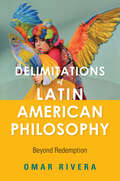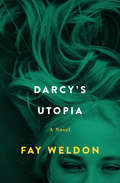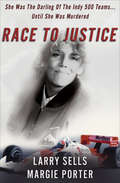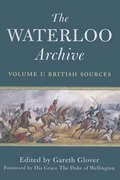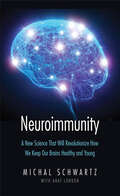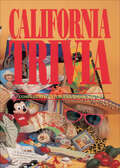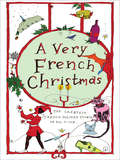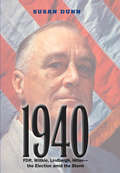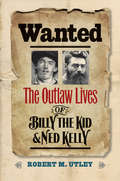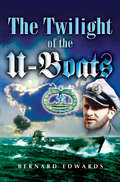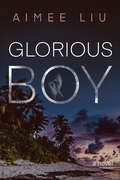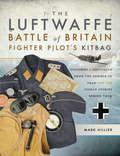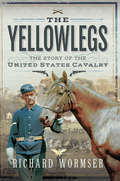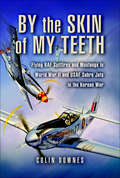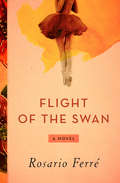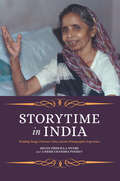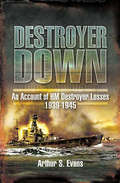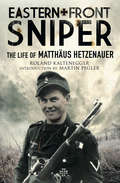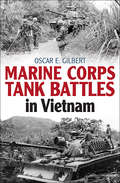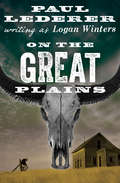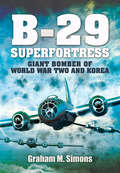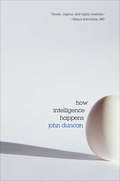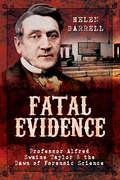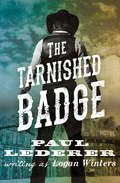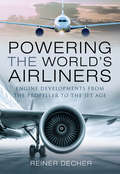- Table View
- List View
Delimitations of Latin American Philosophy: Beyond Redemption (World Philosophies)
by Omar Rivera“[An] original view of José Carlos Mariátegui’s role in Latin American philosophy and his relation to identity, liberation, and aesthetics (Elizabeth Millán Brusslan, editor of After the Avant-Gardes).In the nineteenth and twentieth centuries, Latin American philosophy focused on the convergence of identity formation and political liberation in ethnically and racially diverse postcolonial contexts. In this book, Omar Rivera interprets how a “we” is articulated and deployed in this robust philosophical tradition. With close readings of Peruvian political theorist José Carlos Mariátegui, he also examines texts by José Martí, Simón Bolívar, and others.Rivera critiques philosophies of liberation that frame the redemption of oppressed identities as a condition for bringing about radical social and political change. Shining a light on Latin America’s complex histories and socialities, he illustrates the power and shortcomings of these projects.Building on this critical approach, Rivera studies interrelated epistemological, transcultural, and aesthetic delimitations of Latin American philosophy in order to explore the possibility of social and political liberation “beyond redemption.”
Darcy's Utopia: A Novel
by Fay WeldonFrom the internationally bestselling author of The Hearts and Lives of Men and The Life and Loves of a She-Devil comes a novel that asks a provocative question: If you ruled the world, what would you do? Eleanor Darcy has come up in the world. With her second husband in prison for financial crimes against the nation, she is a media sensation. A self-professed &“feminist of the socialist variety,&” Eleanor grants an exclusive interview to Hugh Vansitart and Valerie Jones, a pair of ambitious journalists. Her vision of the future includes the abolition of money and society-approved procreation, a world in which &“all men will believe in God and be capable of love.&” During the course of their interviews, Hugh and Valerie succumb to some erotic impulses of their own, while Eleanor goes on to become patron saint of the Darcian Movement. From the storyteller who is constantly measuring the moral pulse of men and women, Darcy&’s Utopia is an uproarious and subversive riff on the age-old battle of the sexes.
Race to Justice
by Larry Sells Margie PorterThe murder case of chef Cynthia Albrecht that shocked the Indy 500 racing world—as seen on Investigation Discovery&’s True Conviction. Cynthia Albrecht, the executive chef of the Penske-Marlboro racing team and darling of the IndyCar circuit, went missing on October 25, 1992—the night before her divorce from Michael Albrecht became final. Drivers and racing crews from across the country converged on &“The Brickyard,&” site of the Indianapolis 500, to help search for her. As the head mechanic for the Dick Simon racing team, known as &“Crabby&” across the race circuit, Michael had a reputation for bullying and abuse. He&’d immediately become a suspect in Cynthia&’s disappearance. But with a strong alibi, there was nothing authorities could do when he decided to take a vacation to Florida and skip a scheduled polygraph test and the search for his estranged wife. Nor could law enforcement charge him when Cynthia&’s body was found a few weeks later in northern Indiana—minus her head. The case went cold for six years until a newly elected prosecutor allowed his deputies to charge Michael Albrecht with murder. But would they be able to prove his guilt? This riveting legal thriller is a finalist in the True Crime category of the Best Book Awards sponsored by American Book Fest. Written by one of the prosecutors, Larry Sells, and journalist Margie Porter, it runs at full throttle and will leave you on the edge of your seat right up to the checkered flag at the final verdict.
The Waterloo Archive Volume I: Volume 1: British Sources (The Waterloo Archive #1)
by His Grace the Duke of WellingtonOriginally published in 1900, this book features excerpts from Alexander Cavali Mercer's account of the battle of Waterloo. As an artillery officer at the sharp end, this is his eye-witness account of the events that lead to Napoleon's final defeat in June 1815. This is the contemporary view of how the events were conveyed to the public of Great Britain. Featuring original engravings from the Illustrated London News and the Graphic, and many paintings from the era, this book was written during the height of the British Empire, and the triumphalist mood of the day is reflected in the tone of the text. This detailed military history provides an echo of the contemporary attitudes to this turbulent time which shaped the destiny of the British Empire. This book is part of the 'Military History From Primary Sources' series, a new military history range compiled and edited by Emmy Award winning author and historian Bob Carruthers. The series draws on primary sources and contemporary documents to provide a new insight into the true nature of warfare. The series consultant is David Mcwhinnie, creator of the award winning PBS series 'Battlefield'.
Neuroimmunity: A New Science That Will Revolutionize How We Keep Our Brains Healthy and Young
by Michal Schwartz Anat LondonHow pathbreaking research into the brain’s connections to the immune system offers new hope for treating diseases, injuries, and the effects of aging. PROSE Awards Honorable Mention, Biomedicine & Neuroscience categoryIn the past, the brain was considered an autonomous organ, self-contained and completely separate from the body’s immune system. But over the past twenty years, neuroimmunologist Michal Schwartz, together with her research team, not only has overturned this misconception but has brought to light revolutionary new understandings of brain health and repair. In this book Schwartz describes her research journey, her experiments, and the triumphs and setbacks that led to the discovery of connections between immune system and brain. Schwartz, with Anat London, also explains the significance of the findings for future treatments of brain disorders and injuries, spinal cord injuries, glaucoma, depression, and other conditions such as brain aging and Alzheimer’s and Parkinson’s diseases.Scientists, physicians, medical students, and all readers with an interest in brain function and its relationship to the immune system in health and disease will find this book a valuable resource. With general readers in mind, the authors provide a useful primer to explain scientific terms and concepts discussed in the book.
California Trivia
by Lucy Poshek Roger NaylorTest your California knowledge with this trivia book covering the state’s rich history, geography, sports, culture, notable figures, and more!Home of Hollywood, Redwood National Park, and the 1849 Gold Rush, California is a fascinating state, and California Trivia is full of facts to prove it. This book is the ultimate resource on the who, what, when, where, why, and how of the Golden State. Filled with interesting questions and fascinating facts, California Trivia will provide hours of entertainment and education. Easily adaptable for use with trivia format games, it focuses on the history, culture, people, and places of California.
A Very French Christmas: The Greatest French Holiday Stories of All Time (Very Christmas)
by Alphonse Daudet Anatole France Irène Némirovsky Dominique Fabre Jean-Philippe Blondel Paul Arène François Coppée Antoine Gustave Droz Guy de Maupassant Anatole Le BrazJoyeux Noël: &“[An]endearing collection of Christmas stories from ten of France&’s most esteemed writers―past and present―skillfully translated.&” ―Foreword Reviews This collection brings together the best French Christmas stories of all time, featuring classics by Guy de Maupassant and Alphonse Daudet, plus stories by the esteemed twentieth century authors Irène Némirovsky and Nobel Prize winner Anatole France and contemporary writers Dominique Fabre and Jean-Philippe Blondel. With a holiday spirit conveyed through sparkling Paris streets, opulent feasts, wandering orphans, kindly monks, homesick soldiers, oysters, crayfish, ham, bonbons, flickering desire, and more than a little wine, this collection encapsulates Christmas à la française—delicious, intense and unexpected.
1940: FDR, Willkie, Lindbergh, Hitler—the Election amid the Storm
by Susan DunnA history of the 1940 U.S. presidential election, when bitterly divided Americans debated the fate of the nation and the world. In 1940, against the explosive backdrop of the Nazi onslaught in Europe, two farsighted candidates for the U.S. presidency—Democrat Franklin D. Roosevelt, running for an unprecedented third term, and talented Republican businessman Wendell Willkie—found themselves on the defensive against American isolationists and their charismatic spokesman Charles Lindbergh, who called for surrender to Hitler's demands. In this dramatic account of that turbulent and consequential election, historian Susan Dunn brings to life the debates, the high-powered players, and the dawning awareness of the Nazi threat as the presidential candidates engaged in their own battle for supremacy. 1940 not only explores the contest between FDR and Willkie but also examines the key preparations for war that went forward, even in the midst of that divisive election season. The book tells an inspiring story of the triumph of American democracy in a world reeling from fascist barbarism, and it offers a compelling alternative scenario to today&’s hyperpartisan political arena, where common ground seems unattainable. &“Anyone today who believes that U.S. involvement and the ultimate Allied triumph in World War II was inevitable must read this important history."—Michael Beschloss, New York Times bestselling author of Presidential Courage &“Susan Dunn, a prolific and outstanding historian, has crafted a fast-paced, serious, and extraordinarily well-researched book about the events surrounding the pivotal 1940 election. Her main characters…come brilliantly to life. I could hardly put the book down.&”—James T. Patterson, author of Bancroft Prize-winning Grand Expectations: The United States, 1945-1974
Wanted: The Outlaw Lives of Billy the Kid & Ned Kelly (The Lamar Series in Western History)
by Robert M. UtleyTwo famous 19th century outlaws from opposite sides of the world are brought to rollicking life in the acclaimed historian&’s &“marvelous dual biography&” (Douglas Brinkley, author of The Wilderness Warrior). The legendary exploits of Billy the Kid and Ned Kelly live on in the public imaginations of their respective countries, the United States and Australia. But the outlaws&’ reputations are so mythologized, the truth of their lives has become obscure. In Wanted, Robert M. Utley reveals the true stories and parallel courses of the two notorious contemporaries who lived by the gun, were executed while still in their twenties, and remain compelling figures in the folklore of their homelands. Utley draws sharp portraits of both young men, offering insightful comparisons of their lives and legacies. Billy was a fun-loving sharpshooter who excelled at escape and lived on the run after indictment for his role in the Lincoln Country War. While Ned, raised in the bush by his Irish convict father, was driven by outrage against British colonial authority to steal cattle and sheep, kill three policemen, and rob banks for the benefit of impoverished Irish sympathizers. Recounting their exploits, differences, and shared fates, Utley illuminates the worlds in which they lived on opposite sides of the globe. &“Robert M. Utley displays the gifts that have made him a storied interpreter of the nineteenth-century west.&”—T. J. Stiles, Pulitzer Prize-winning author of The First Tycoon
The Twilight of the U-Boats
by Bernard Edwards“A gripping narrative” of the German submarines that nearly changed the outcome of World War II from the author of Dönitz and the Wolf Packs (Naval Review).In essence, this is the story of U-223, commanded by Karl-Jurgen Wächter from the time of her commissioning in Kiel in January 1943 through a murderous career to her eventual but dramatic demise in the Mediterranean in March 1944. At the same time, the book covers the declining fortunes of the U-boat arm as a whole from early 1943 when it seemed invincible and seriously threatened the Allies with defeat to the end of the war.“An intimate narrative, one driven by human endurance and frailty.” —Amsterdam Nautical College Newsletter
Glorious Boy: A Novel
by Aimee E. Liu“An absolutely gorgeous historical novel . . . set against the backdrop of a tribe in the Andamans struggling with British rule . . . Just magnificent.” —Caroline Leavitt, New York Times bestselling author of Pictures of YouOne of Booklist’s Top Ten Historical Fiction Books of 2020Glorious Boy is a tale of war and devotion, longing and loss, and the power of love to prevail. Set in India’s remote Andaman Islands before and during WWII, the story revolves around a mysteriously mute four-year-old who vanishes on the eve of the Japanese occupation. Little Ty’s parents, Shep and Claire, will go to any lengths to rescue him, but neither is prepared for the brutal and soul-changing odyssey that awaits them.“A riveting amalgam of history, family epic, anticolonial/antiwar treatise, cultural crossroads, and more . . . a fascinating, irresistible marvel.” —Library Journal (starred review)“The most memorable and original novel I’ve read in ages . . . evokes every side in a multi-cultural conversation with sympathy and rare understanding.” —Pico Iyer, author of Autumn LightShortlisted for the Staunch Book PrizeNew York Post’s Best Books of the WeekGood Housekeeping’s 20 Best Books of 2020Parade’s 30 Best Beach Reads of 2020
The Luftwaffe Battle of Britain Fighter Pilot's Kitbag: Uniforms & Equipment from the Summer of 1940 and the Human Stories Behind Them
by Mark Hillier&“Detail[s] German fighter pilots&’ flying helmets, oxygen masks, goggles . . . and other ephemera . . . brilliantly done—and completely engrossing.&”—The Aviation Historian Reichsmarschall Gring told Hitler that it would take less than a month for his much-vaunted Luftwaffe to conquer the RAF and pave the way for the German invasion of Great Britain. His prediction was to prove disastrously wrong, but for four long months his pilots and aircrew fought for their lives in the skies above the UK. From their bases in continental Europe, the Luftwaffe&’s fighter pilots escorted the great bomber fleets that sought to destroy the RAF&’s airfields and installations, and tackled the Spitfires and Hurricanes deployed to defend Britain&’s towns and cities. Whilst much has been written on the titanic struggle for supremacy fought throughout the summer of 1940 and of the men and machines of both sides, little attention has been paid to what the pilots wore and carried with them in the air. All the objects that a Luftwaffe fighter pilot was issued with during the Battle of Britain are explored in this book in high-definition color photographs, showing everything from the differing uniforms, to headgear, personal weapons, gloves, goggles, parachute packs and the essential life jacket. Each item is fully described and its purpose and use explained. Fly with the Messerschmitt Bf 109s and Bf 110s across the Channel and see what the Luftwaffe aircrew wore as they took on Fighter Command in what was justly called the Battle of Britain. &“An outstanding example of history through artifacts.&”—Schopenhauer's Workshop
The Yellowlegs: The Story of the United States Cavalry
by Richard WormserThe colorful, action-packed early history of the horse-riding branch of the U.S. Army. In this comprehensive and lively account, Richard Wormser—who was himself an enthusiastic horseman—narrates the major events and characters of the U.S. Cavalry&’s formative, and, some might say fruitful, years. From the American Revolution and the exploits of men such as Henry &“Light-Horse Harry&” Lee III and Francis Marion, the first of the guerrillas, the author follows on with Stephen Kearny, the &“Father of the Cavalry&” whose dragoons went west to California on mules, and his nephew Philip, who organized the famed Gray Horse Troop of the Mexican War. Other famous names featured include Jonathan &“Stonewall&” Jackson; George Crook, who admired the Indians it was his duty to hunt down; and George Armstrong Custer. A U.S. Army officer and cavalry commander who served with distinction in the American Civil War, Custer is most remembered for leading more than 200 of his men to their deaths in the Battle of the Little Bighorn in June 1876. Also known as &“Custer&’s Last Stand&’, Bighorn was part of the Black Hills War against a confederation of Plains Indians, including the Cheyenne and Dakota Sioux. It remains one of the most controversial battles in American history. Roosevelt&’s Roughriders and Black Jack Pershing, who led his troops in an automobile, complete the narrative—one which is undoubtedly a saga of daring raids, of epic marches, and of grueling battles. As the author reveals, the story of the U.S. Cavalry is also the story of the birth and growth of America itself.
By the Skin of My Teeth: Flying RAF Spitfires and Mustangs in World War II and USAF Sabre Jets in the Korean War
by Colin DownesA career pilot&’s memoir of flying fighter jets through two wars and through the evolution of aviation technology. This is Colin Downes&’s firsthand account of flying with the Royal Air Force in war and peace during a career in military and civil aviation covering a half century. The text is filled with his personal experiences, reminiscences and impressions and is written in four parts. Part One covers the years leading to Downes&’s graduation and the winning of his RAF Wings. This is followed by action-packed stories of flying propeller-driven fighters, Spitfires and Mustangs, during and just after the Second World War. Downes then tells of his unique experiences of front-line fighter operations when he flew jets with the United States Air Force during the Korean War. The final chapter covers the remainder of his RAF Service flying until retirement. By the Skin of My Teeth offers a cockpit view of some of the most pivotal battles of the 20th century and covers decades of technological advancements in aircraft development.
Flight of the Swan: A Novel
by Rosario FerréA renowned Russian ballerina is stranded in Puerto Rico as a revolution tears her homeland apart—and she finds herself in the middle of another uprisingIn a truly multicultural story and a daring example of global fiction, Rosario Ferré uses her prodigious talents to deliver an unforgettable tale of love, politics, and the power of female expression. Based loosely on a real episode in the life of famous prima ballerina Anna Pavlova, Flight of the Swan follows Niura Federovsky as she flees Russia when revolution breaks out in 1917.Adrift in San Juan, Niura falls in love with a much younger man. Her passion for revolutionary Diamantino Márquez mirrors the turmoil of the strife-torn island, and her dance troupe soon becomes caught up in Puerto Rico&’s struggle for independence. Niura&’s maid and confidant, Masha, the heart and soul of the novel, is devastated by Madame&’s apparent abandonment of her art. Masha tries to save her mistress from heartbreak—only to lose her own heart to a most unexpected arrival.
Storytime in India: Wedding Songs, Victorian Tales, and the Ethnographic Experience
by Umesh Chandra Pandey Helen Priscilla MyersAn American ethnomusicologist and her Indian collaborator recount their experiences researching Bhojpuri wedding songs in India.Stories are the backbone of ethnographic research. During fieldwork, subjects describe their lives through stories. Afterward ethnographers come home from their journeys with stories of their own about their experiences in the field.Storytime in India is an exploration of the stories that come out of ethnographic fieldwork. Helen Priscilla Myers and Umesh Chandra Pandey examine the ways in which their research collecting Bhojpuri wedding songs became interwoven with the stories of their lives, their work together, and their shared experience reading The Eustace Diamonds by Anthony Trollope. Moving through these intertwined stories, the reader learns about the complete Bhojpuri wedding tradition through songs sung by Gangajali and access to the original song recordings and their translations. In the interludes, Pandey reads and interprets The Eustace Diamonds, confronting the reader with the ever-present influence of colonialism, both in India and in ethnographic fieldwork. Interwoven throughout are stories of the everyday, highlighting the ups and downs of the ethnographic experience.Storytime in India combines the style of the Victorian novel with the structure of traditional Indian village tales, in which stories are told within stories. This book questions how we can and should present ethnography as well as what we really learn in the field. As Myers and Pandey ultimately conclude, writers of scholarly books are storytellers themselves and scholarly books are a form of art, just like the traditions they study.
Destroyer Down: An Account of HM Destroyer Losses, 1939–1945
by Arthur EvansThe author of Beneath the Waves provides a thorough history of the sinkings of Britain&’s destroyer warships during World War II. His Majesty&’s destroyers had a long and costly war. Some eight thousand destroyer men did not survive. At the height of the war the Royal navy was commissioning four new vessels a month, which was only sufficient to replace those which had been sunk or severely damaged. This outstanding book contains the details of the majority of the sinkings that occurred throughout World War II and includes many firsthand accounts from the officers and crew involved.
Eastern Front Sniper: The Life of Matthäus Hetzenauer (Greenhill Sniper Library)
by Roland KalteneggerEastern Front Sniper is a long overdue and comprehensive biography of one of World War IIs most accomplished snipers.Mathus Hetzenauer, the son of a Tyrolean peasant family, was born in December 1924. He was drafted into the Mountain Reserve Battalian 140 at the age of 18 but discharged five months later.He received a new draft notice in January 1943 for a post in the Styrian Truppenbungsplatz Seetal Alps where he met some of the best German snipers and learned his art.Hetzenauer went on to fight in Romania, Eastern Hungary and in Slovakia. As recognition for his more than 300 confirmed kills he was awarded on the Knight's Cross of the Iron Cross on April 17, 1945.After nearly five years of Soviet captivity Mathus Hetzenauer returned to Austria on January 10, 1950. He lived in the Tyrol's Brixen Valley until his death on 3 October of 2004.
Marine Corps Tank Battles in Vietnam
by Oscar E. GilbertThe author of Tanks in Hell tracks ten years of tank warfare in Vietnam, combining firsthand accounts from veterans with analysis of tactics and strategy. In 1965 the large, loud, and highly visible tanks of 3rd Platoon, B Company, 3rd Tank Battalion landed across a beach near Da Nang, drawing unwelcome attention to America&’s first, almost covert, commitment of ground troops in South Vietnam. As the Marine Corps presence grew inexorably, the 1st and 3rd Tank Battalions, as well as elements of the reactivated 5th Tank Battalion, were committed to the conflict. For the United States Marine Corps, the protracted and bloody struggle was marked by controversy, but for Marine Corps tankers it was marked by bitter frustration as they saw their own high levels of command turn their backs on some of the hardest-won lessons of tank-infantry cooperation learned in the Pacific War and in Korea. Nevertheless, like good Marines, the officers and enlisted men of the tank battalions sought out the enemy in the sand dunes, jungles, mountains, paddy fields, tiny villages, and ancient cities of Vietnam. Young Marine tankers fresh out of training, and cynical veterans of the Pacific War and Korea, battled two enemies. The battle-hardened Viet Cong were masters of the art of striking hard, then slipping away to fight another day. The highly motivated troops of the North Vietnamese Army, equipped with long-range artillery and able to flee across nearby borders into sanctuaries where the Marines were forbidden to follow, engaged the Marines in brutal conventional combat. Both foes were equipped with modern anti-tank weapons, and sought out the tanks as valuable symbolic targets. It was a brutal and schizophrenic war, with no front and no rear, absolutely no respite from constant danger, against a merciless foe hidden among a helpless civilian population. Some of the duties the tankers were called upon to perform were long familiar, as they provided firepower and mobility for the suffering infantry in a never-ending succession of search and destroy operations, conducted amphibious landings, and added their heavy guns to the artillery in fire support missions. Under constant threat of ambushes and huge command-detonated mines that could obliterate both tank and crew in an instant, the tankers escorted vital supply convoys, and guarded the engineers who built and maintained the roads. In their &“spare time&” the tankers guarded lonely bridges and isolated outposts for weeks on end, patrolled on foot to seek out the Viet Cong, operated roadblocks and ambushes, shot up boats to interdict the enemy&’s supply lines, and worked in the villages and hamlets to better the lives of the brutalized civilians. To the bitter end—despite the harsh conditions of climate and terrain, confusion, endless savage and debilitating combat, and ultimate frustration as their own nation turned against the war—the Marine tankers routinely demonstrated the versatility, dedication to duty, and matchless courage that Americans have come to expect of their Marines.
On the Great Plains
by Paul LedererIn a deserted cabin on the Great Plains, a settler tries to make a homeRincon and his two companions ride out of the frigid night, and demand shelter in the sagging old cabin. They have gold in their saddlebags and the army on their tail, and they need a place to lay low. Letting them inside is the worst mistake the Whittaker brothers will ever make. The riders gun one brother down, and are holding the other hostage when the army surrounds the house. The soldiers unload on the cabin, peppering it with a hundred rounds of ammunition, and killing everyone inside except Rincon. They have their prisoner—but they don&’t find the gold.When Ben Flowers settles in the territory, he&’s told the cabin is haunted by the men killed that night. He tries to make a home for himself in the abandoned structure, but as long as that gold is on his property he will never have peace.
B-29 Superfortress: Giant Bomber of World War Two and Korea
by Graham M. Simons&“A well written history of a history-changing aircraft,&” the bomber that carried the two atomic bombs that destroyed Hiroshima and Nagasaki in WWII (Aeromilitaria). The Boeing B-29 Superfortress was a four-engined heavy bomber flown primarily by the United States in World War Two and the Korean War. The name &“Superfortress&” was derived from that of its well-known predecessor, the B–17 Flying Fortress. The B-29 was the progenitor of a series of Boeing-built bombers, reconnaissance aircraft, trainers and tankers including the variant, B-50 Superfortress. The B-29 was one of the largest aircraft to see service during World War Two. A very advanced bomber for its time, it included features such as pressurized cabins, an electronic fire-control system and remote-controlled machine-gun turrets. Though it was designed as a high-altitude daytime bomber, in practice it actually flew more low-altitude nighttime incendiary bombing missions. It was the primary aircraft in the American firebombing campaign against Japan in the final months of World War Two. Unlike many other World War Two-era bombers, the B-29 remained in service long after the war ended, with a few even being employed as flying television transmitters. The type was finally retired in the early 1960s, with 3,960 aircraft in all built. Without doubt there is a clear, strong requirement to &“put the record straight&” using primary source documentation to record the undoubted achievements alongside and in context with the shortcomings to the type&’s design and operation that have otherwise received scant attention. The book covers all variants and is profusely illustrated.
How Intelligence Happens
by John DuncanA lively journey through the brain&’s inner workings from &“one of the world&’s leading cognitive neuroscientists&” (The Wall Street Journal). Human intelligence builds sprawling cities, vast cornfields, and complex microchips. It takes us from the atom to the limits of the universe. How does the biological brain, a collection of billions of cells, enable us to do things no other species can do? In this book, neuroscientist John Duncan offers an adventure story—the story of the hunt for basic principles of human intelligence, behavior, and thought. Using results drawn from classical studies of intelligence testing; from attempts to build computers that think; from studies of how minds change after brain damage; from modern discoveries of brain imaging; and from groundbreaking recent research, he synthesizes often difficult-to-understand information into clear, fascinating prose about how brains work. Moving from the foundations of psychology, artificial intelligence, and neuroscience to the most current scientific thinking, How Intelligence Happens is &“a timely, original, and highly readable contribution to our understanding&” (Nancy Kanwisher, MIT) from a winner of the Heineken Prize for Cognitive Science
Fatal Evidence: Professor Alfred Swaine Taylor & the Dawn of Forensic Science
by Helen Barrell&“An engrossing read . . . Her description of the ways in which forensic experiments evolved is as fascinating as the courtroom dramas they accompanied.&” —Jess Kidd, The Guardian, &“Best Summer Books 2018, as Picked by Writers&” A surgeon and chemist at Guys Hospital in London, Professor Alfred Swaine Taylor used new techniques to search the human body for evidence that once had been unseen. As well as tracing poisons, he could identify blood on clothing and weapons, and used hair and fiber analysis to catch killers. Taylor is perhaps best remembered as an expert witness at one of Victorian England&’s most infamous trials—that of William Palmer, &“The Rugeley Poisoner.&” But he was involved in many other intriguing cases, from a skeleton in a carpet bag to a fire that nearly destroyed two towns, and several poisonings in between. Taylor wrote widely on forensic medicine. He gave Charles Dickens a tour of his laboratory, and Wilkie Collins owned copies of his books. His work was known to Sir Arthur Conan Doyle, and he inspired the creation of fictional forensic detective Dr. Thorndyke. For Dorothy L. Sayers, Taylors books were the back doors to death. From crime scene to laboratory to courtroom and sometimes to the gallows, this is the world of Professor Alfred Swaine Taylor and his fatal evidence. &“A must read for any lover of crime writing, criminology, and Victorian cultural history.&” —Fortean Times &“Totally fascinating . . . Refers to many famous and not-so-famous cases, as well as giving an insight into this clever, enthusiastic, honourable and dedicated man. Very clearly written and very enjoyable read.&” —Michelle Birkby, author of The Baker Street Inquiries series
The Tarnished Badge
by Paul LedererThe men of a posse on the trail of an outlaw begin to turn on one anotherWhat made Jake Worthy rob his hometown bank? Was it stupidity? Daring? Or did he simply not think the men of Quirt, Arizona, had the skill to catch him? Three days out of Quirt, the group sent after Worthy is coming apart at the seams. The richest man in town is complaining about the hardships of the trail. Alongside him are a couple of greenhorns, a few refugees from the saloon, and a redheaded man whose steely confidence the sheriff simply does not trust. By law, the chase must end at the county line—but Sheriff Fawcett fears the posse is beyond his control.To capture Worthy and retrieve the stolen gold, the men of Quirt will push themselves to the limit, even if it means turning outlaw themselves.
Powering the World's Airliners: Engine Developments from the Propeller to the Jet Age
by Reiner DecherFrom propellers to turbofans, this illustrated history of engines will be “of interest to modelers and aviation historians alike” (AMPS Indianapolis).The first efforts of man to fly were limited by his ability to generate sufficient power to lift a heavier-than-air machine off the ground. Propulsion and thrust have therefore been the most fundamental elements in the development of aircraft engines.From the simple propellers of the first airliners of the 1920s and 1930s, to the turboprops and turbojets of the modern era, the engines used in airliners have undergone dramatic development over a century of remarkable change. These advances are examined in detail by aeronautical engineer Reiner Decher, who provides a layman’s guide to the engines that have, and continue to, power the aircraft that carry millions of travelers across millions of miles each year. Decher also looks at the development of aero engines during the Second World War and how that conflict drove innovation and explains the nature of wing design, from the early twentieth century to the present.To enable an easy understanding of this intriguing subject, Powering the World’s Airliners is profusely illustrated, transporting readers back to the time of each major development and introducing them to the key individuals of the aero industry in each era. After reading this comprehensive yet engaging story of the machines that power the aircraft in which we fly, no journey will ever seem quite the same again.
